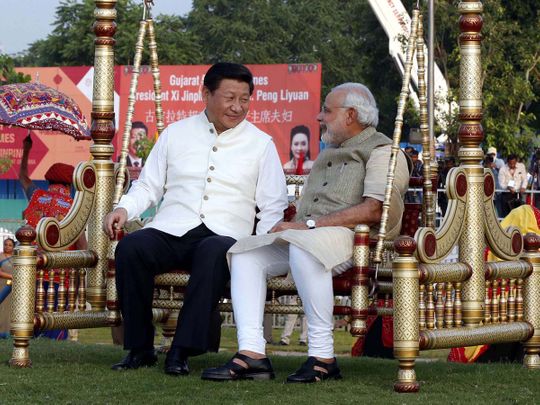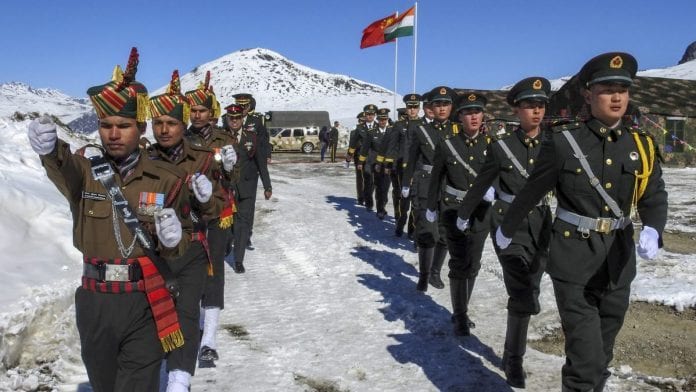India-China Border Clashes: Outfoxed & cornered

Ties on Upswing? Modi & Jinping in Ahmedabad in September 2014 during their short-lived honeymoon
After a brief honeymoon with Chinese President Xi Jinping, Prime Minister Narendra Modi has consistently failed to read Jinping and has frequently been caught off-guard by the Chinese leader.
After a hiatus of six weeks following the first bloody clash between Indian and Chinese armies at Line of Actual Control at Galwan in Ladakh, India has again complained to China about its forces transgressing the border again and trying to occupy more Indian territory on the southern banks of the strategic Pangong Tso lake which has become a centre of attention and repeated disputes between the two Asian neighbours.
India says that Chinese soldiers had occupied fresh Indian territory on the southern bank of the lake and that talks were going on between the two sides to resolve the latest dispute amicably. The reports of the latest incursion indicate a clear pattern in the manner that China has handled not just India but practically all of its neighbours – from the East China Sea to the Bay of Bengal through the South China Sea. The Chinese persistently make small incursions or post their flags in no man’s land and depending upon the response that it generates, either Beijing would call off its forces or go the whole distance and establish itself as the ‘rightful owner’ of the territory.
In relations with India, China first used this tactic three years ago in Doklam, a strategically located plateau on the tri-national border between China, India and Bhutan. India had accused Chinese forces of occupying this strategic piece of land which could seriously undermine connectivity to India’s Northeast. After a 73-day standoff between the two forces, conflict gave way to consultations and an agreement was reached, where the two forces agreed to pull back. China was also supposed to stop building roads and other infrastructure in the region.
Doklam was the worst standoff tween the two sides over two decades and it showed greater competition between India and China in the region, most of all a strategic competition and a show of muscle power. Doklam also reflected growing differences between India and China over numerous developments in the region, including the Belt & Road Initiative of Jinping as well as Chinese attempts to build a string of pearls in the Bay of Bengal and the Arabian Sea in an attempt to surround India with territories which have a significant Chinese presence, military or civil.
Doklam had become the biggest bilateral crisis between India and China for decades and the ties between the two were at an ebb as was mutual confidence. Yet, it did not prevent the Indian government from wrongly proclaiming a win of sorts in Doklam and the pliant media, available in abundance, was used by the Bharatiya Janata Party to proclaim that Prime Minister Modi, with his famous 56-inch chest, had indeed shown Jinping was who the boss was. The staring contest and the beating of drums continued for a few more months, but on the ground, there was little progress as all satellite imagery continued to point that instead of stopping construction work in Doklam, the Chinese had accelerated it.
Then, all of a sudden, India announced that Modi would head to Wuhan for an informal summit with Jinping to resolve the crisis and restore mutual trust in the relationship. However, the details of the agenda of discussion, as well as the status of Doklam, remained sketchy. Modi’s efficient media management ensured that the ‘informal’ summit was projected as yet another conquest by Indian PM with ‘outstanding’ outcomes for India. At the summit, apparently, the two sides agreed to continue discussions on the border dispute and build on areas of mutual cooperation like trade, cultural connection and people to people contacts.
The Wuhan meeting was followed by a visit by Jinping to Mamallapuram in Tamil Nadu in 2019 for yet another ‘informal summit’ that was meant to build the bilateral relations further. But what was left unsaid was that the meeting was necessitated growing Chinese unhappiness over India’s decision to unilaterally abrogate Article 370 of the Indian Constitution, end special status of Jammu & Kashmir and split the state into two separate union territories in an attempt to emasculate the anti-India groups in the valley. As in Wuhan, Mamallapuram meeting was also preceded by weeks of skirmishes between Indian and Chinese forces in Ladakh, especially around the northern banks of Pangong Tso.

For long a sleepy even if undefined border, tensions have mounted dramatically on Indo-China border in the past few years
Once again India declared that the meeting had been successful as the two sides had agreed to bring down the temperatures along the borders and work towards resolving the border issues. In the absence of any official communique or any statement by the two leaders during the summit, New Delhi again projected it as a major victory for Indian, or rather Modi’s, diplomacy and strategy.
Despite these proclamations, tensions have only been rising all along the Sino-Indian border and China seems to have reinforced its infrastructure along the border and bring more men and weapons closer to the border in a clear attempt to browbeat India. On each occasion since Doklam, Jinping has caught Modi and India off guard and continued to strengthen the Chinese position along the borders even while publicly claiming otherwise. Despite the public images of hugs and handshakes or sharing a swing, there seems to be little love lost between two strongmen of Asia.
But it was not always so. Soon after he became Prime Minister in May 2014, Modi had started to reach out to China and build on the bilateral relationship on multiple fronts. Not only did he want to increase Chinese investment into India as well as enhance bilateral trade, but Modi was also keen to promote people to people contacts and improve mutual awareness of the two largest cultures of the world. Barely three months after he took office, Modi invited Jinping to India and the two sides signed several accords. The ties seemed all set to flourish.
Things seemed to progress smoothly until late 2016 when Modi brought about a dramatic shift in Indian foreign policy and prioritised building ties with the United States, even at the cost of ties with other countries. Soon enough India seemed to have jettisoned its independent policies and was just a mirror of the priorities and policies of the White House, signing a number of defence deals as well as other agreements including mounting joint naval exercises along with Japan, South Korea, Australia and United States. None of the participating countries cared to camouflage even slightly that the exercises targetted China.
Irked by seeing India walk into a tight embrace with the United States, Jinping’s China changed gears in South Asia as well. It began building up its infrastructure and force along the border and also penetrate other countries in the region in an attempt to isolate India. Since 2017, Jinping has been playing cat and mouse with India, capitalizing on the huge gap in the military capabilities of the two nations. Not only does China spend well over USD 100 billion more on its defence forces each year, but its capabilities across the entire gamut of the military are beyond India’s reach – be it logistics, infrastructure, material or men.
Jinping has exploited to his advantage the knowledge that even though India never really had a military option vis a vis China, its leaders would keep on boasting otherwise, including the recent claims by Indian Chief of Defence Staff that ‘military option was always on the table’. Jinping has been also playing on fact that Modi would never ever accept to be publicly seen as having yielded ground to Jinping or any other foreign leader as it would puncture forever his carefully cultivated image of a strong and fearless leader.
Thus, to each of the incursions made by Chinese forces in Indian territory, Indian response has been muted and often contradictory. Even during the June standoff in Galwan, Modi claimed that China had not crossed into India, even though the Indian Army clearly stated otherwise. Jinping is bound to continue to exploit this weakness and occupy an ever-larger chunk of Indian land until he can force a weakened Modi, and a fragile India, to accept an unfavourable border deal and sign away for good large chunks of Indian territory in north-west and north-east. The only way Modi can avoid this fate is to place the nation above self. But will he? Only time will tell.









